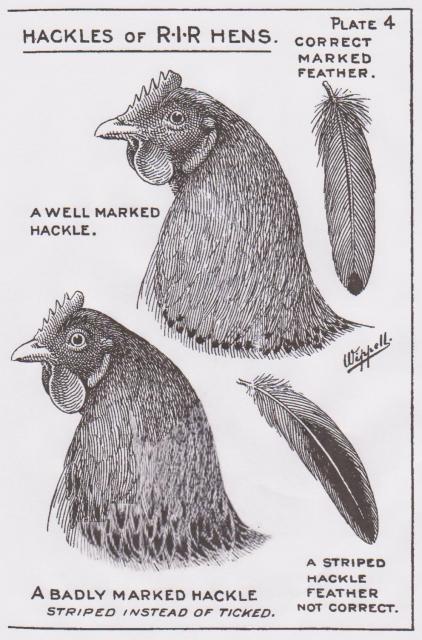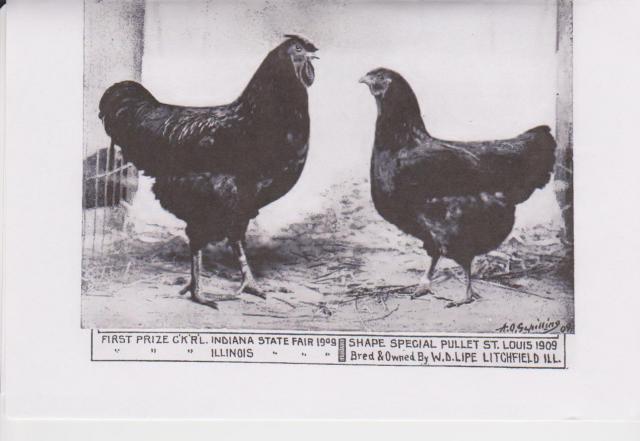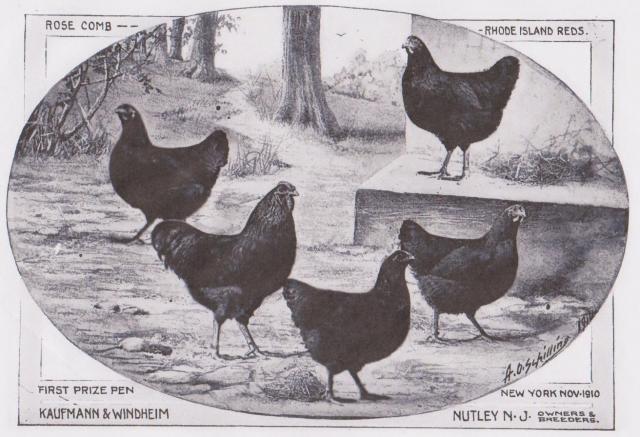THE ORIGIN OF ROSE COMB RHODE ISLAND REDS
BY H. G. DENNIS, in Red Hen Tales.
 1910
1910
Having seen a number of articles in agricultural and
poultry journals on the origin of the Rhode Island Reds,
and being positive in my belief that I know where the progenitors
of the Rose Comb variety came from, with your
permission will say:
That forty-five years ago to my knowledge, there
could be found on the incoming whaleships, and in the
yards of the sailor boarding houses, and those of the Portuguese
and other foreign residents of that part of New
Bedford, bordering on the water front and known as
Fayal, as well as on a number of farms within a radius
of ten miles of the city, many specimens of red rose comb
fowls that were brought from Java, and the adjacent
islands, by the whale ships, and called by the sailors Red
Javas. The Red Javas would come as near, or nearer, to
meeting
the requirements of the Rhode Island Red standard
than the best Reds today do.
In plumage they would excel the present day Reds.
They were of an even colored rich dark red of a shade
difficult to -describe. Both male and female were dark.
The males had an elegant glossy plumage, and with what
was called in those days a bottle green tail. The females
were more subdued in color and had a black tail. They
had combs of a fine slant, of medium width terminating
with a spike, comb full and with prominent serrations,
legs of reddish yellow and medium length.
In conformation they were very long on the keel, and
straight on the back. They were very active and great
foragers and layers. In color there were three varieties of
the Javas; red, white and black, all of the same conformation
and characteristics.
That the Javas were a true or distinct breed is my
belief, as many bantams, miniature productions of the large
variety, were to be found in the places that I have before
named.
In company with some schoolmates, we had at one
time about twenty-five specimens of the Red Javas, about
two-thirds of them males. They were obtained in part
from the ships, others were bought from the foreign residents
along the water front. We kept them in a barn
in the center of the city. They soon caused a protest from
the neighbors, and we had to dispose of most of the males.
They were sold to farmers who brought produce to the
city from Little Compton, Adamsville, Westport, Dartmouth,
and to the farmers of the towns to the north and
east of New Bedford.
As many of the officers of the ships came from the
towns above named and westerly along the coast to New
London, and vessels sailed from Westport Point and New
London, it is fair to presume that some of the Javas
found their way to those sections through that channel.
I have kept the Reds many years and would not keep
any other breed. That the Red Javas were the progenitors
as a whole, or in part, of the Rose Comb Reds of today
is my belief, and there is no theory than can be advanced
or argument brought forth,' that would have any effect on
I am not one of those who is willing to say, "Never
mind the origin of the 'Reds' or any other worthy variety
of fowls." I have been breeding poultry for twenty odd
years, and I am always interested in the origin of every
breed. Go back into history with me fifty years, and we
find that, at that time, 1846-1850, different Asiatic breeds
were introduced into this country, especially in neighborhoods
that were near the coast. One variety, the Shanghai
fowl (yellow and white), was introduced just after the
Cochin China, and the two breeds for a time became confused
and "many farmers and poulterers declare, spite of
feathers, or no feathers (on the legs), that their fowls are
Cochin China's or Shanghais, just as they please." At this
time, Bennett, in his poultry book, says: "There are but
few, if any, bona fide Shanghai fowls now for sale." These
Shanghai fowls (Simon pure) were heavily feathered on
the legs, Not so with Cochin China. At this time the
Cochin China's were bred extensively in Southeastern
Massachusetts and Rhode Island. Dr. Alfred Bayless, of
Taunton, Mass., imported in July, 1846, specimens of the
yellow Cochin China's. "The cockerels were generally red."
These were not specimens of what were called the Royal
Cochin China's, as bred by the Queen of England, but
direct importations, "The Royal Cochin China's were one third
larger." The Shanghais were heavily feathered in
the legs; these imported Cochin China's lightly feathered, if
at all. The ship Huntress, in May, 1847, direct from
Cochin China, brought a pair of this variety of fowls, and
Mr. Taylor, in speaking of them, -says: "The imported
cock was a peculiar red and yellowish Dominique, and the
hen a bay or reddish brown;" that the young stock varied
"only in shade of color," Bennett says: "The legs of both,
sexes are of reddish yellow, sometimes, especially in the
cocks, decidedly redmore so than in any other variety."
How many times I have called attention to the red pigment
in a Rhode Island Red cock's legs.
So much, then, for the Red Cochin China cock of fifty
years ago. The sea captains brought home just such specimens
to Little Compton, R. I., but a little later came the
great Malay fowl, with its knotty knob of a comba comb
that even today occasionally is to be seen on the Rhode
Island Reds. The Jersey BluesBucks County and
Boobieswere inferior varieties of Malay. The Great
Malays came from the peninsula of that name at the
southern point of the continent of Asia. They were
spoken of as "serpent headed." Their color was dark
brown or reddish, streaked with yellow; some varieties of
Malays ran more red than others. In Little Compton,
was introduced what was spoken of as the Red Malay.
The Red Cochin China cocks and the Red Malay cocks were
selected, and crossed with the flocks of fowls in Little
Compton, forty and fifty years ago, the same as today.
Later, before the Wyandotte fever, the R. C. Brown Leghorn
was introduced into many flocks in this neighborhood.
Even at the time of the introduction of the Leghorn
blood, the Red fowls were spoken of as Rhode Island Reds.
In a certain section, a section where the Leghorn blood
was not used, . today old settlers speak of their fowls as
Red Malays; in this section ten years ago, the Reds were
all of the single comb variety, whereas, ten or twelve
miles further south were to be found rose combs in
abundance.
Now, Mr. Editor, let me say right here, and I wish
to say it plainly, there practically were no Pea Comb Reds
ten years ago, any more than today. Why should Rhode
Island Red fowls have pea combs? Where is the comb
to come from? It is not the common comb of barnyard
fowl. It is not the comb of any of the varieties that made
the Rhode Island Reds. I should just as much expect to
see the Reds with topknots as with pea combs, and if
Mr. Anybody wants to put topknots on them, go ahead,
only he can't sail in the Rhode Island Red boat this year.
Of course, he can sail in his own boatand who cares.
The Pea Comb, Rocks were once admitted to the Standard,
only to be dropped again. I do not believe the Red Club
will admit Pea Combs only to drop them again. Those
that raise Reds feel differently about Pea Combs from
some of those that raise their pen and ink simply to write
about them.
Chris
BY H. G. DENNIS, in Red Hen Tales.

Having seen a number of articles in agricultural and
poultry journals on the origin of the Rhode Island Reds,
and being positive in my belief that I know where the progenitors
of the Rose Comb variety came from, with your
permission will say:
That forty-five years ago to my knowledge, there
could be found on the incoming whaleships, and in the
yards of the sailor boarding houses, and those of the Portuguese
and other foreign residents of that part of New
Bedford, bordering on the water front and known as
Fayal, as well as on a number of farms within a radius
of ten miles of the city, many specimens of red rose comb
fowls that were brought from Java, and the adjacent
islands, by the whale ships, and called by the sailors Red
Javas. The Red Javas would come as near, or nearer, to
meeting
the requirements of the Rhode Island Red standard
than the best Reds today do.
In plumage they would excel the present day Reds.
They were of an even colored rich dark red of a shade
difficult to -describe. Both male and female were dark.
The males had an elegant glossy plumage, and with what
was called in those days a bottle green tail. The females
were more subdued in color and had a black tail. They
had combs of a fine slant, of medium width terminating
with a spike, comb full and with prominent serrations,
legs of reddish yellow and medium length.
In conformation they were very long on the keel, and
straight on the back. They were very active and great
foragers and layers. In color there were three varieties of
the Javas; red, white and black, all of the same conformation
and characteristics.
That the Javas were a true or distinct breed is my
belief, as many bantams, miniature productions of the large
variety, were to be found in the places that I have before
named.
In company with some schoolmates, we had at one
time about twenty-five specimens of the Red Javas, about
two-thirds of them males. They were obtained in part
from the ships, others were bought from the foreign residents
along the water front. We kept them in a barn
in the center of the city. They soon caused a protest from
the neighbors, and we had to dispose of most of the males.
They were sold to farmers who brought produce to the
city from Little Compton, Adamsville, Westport, Dartmouth,
and to the farmers of the towns to the north and
east of New Bedford.
As many of the officers of the ships came from the
towns above named and westerly along the coast to New
London, and vessels sailed from Westport Point and New
London, it is fair to presume that some of the Javas
found their way to those sections through that channel.
I have kept the Reds many years and would not keep
any other breed. That the Red Javas were the progenitors
as a whole, or in part, of the Rose Comb Reds of today
is my belief, and there is no theory than can be advanced
or argument brought forth,' that would have any effect on
I am not one of those who is willing to say, "Never
mind the origin of the 'Reds' or any other worthy variety
of fowls." I have been breeding poultry for twenty odd
years, and I am always interested in the origin of every
breed. Go back into history with me fifty years, and we
find that, at that time, 1846-1850, different Asiatic breeds
were introduced into this country, especially in neighborhoods
that were near the coast. One variety, the Shanghai
fowl (yellow and white), was introduced just after the
Cochin China, and the two breeds for a time became confused
and "many farmers and poulterers declare, spite of
feathers, or no feathers (on the legs), that their fowls are
Cochin China's or Shanghais, just as they please." At this
time, Bennett, in his poultry book, says: "There are but
few, if any, bona fide Shanghai fowls now for sale." These
Shanghai fowls (Simon pure) were heavily feathered on
the legs, Not so with Cochin China. At this time the
Cochin China's were bred extensively in Southeastern
Massachusetts and Rhode Island. Dr. Alfred Bayless, of
Taunton, Mass., imported in July, 1846, specimens of the
yellow Cochin China's. "The cockerels were generally red."
These were not specimens of what were called the Royal
Cochin China's, as bred by the Queen of England, but
direct importations, "The Royal Cochin China's were one third
larger." The Shanghais were heavily feathered in
the legs; these imported Cochin China's lightly feathered, if
at all. The ship Huntress, in May, 1847, direct from
Cochin China, brought a pair of this variety of fowls, and
Mr. Taylor, in speaking of them, -says: "The imported
cock was a peculiar red and yellowish Dominique, and the
hen a bay or reddish brown;" that the young stock varied
"only in shade of color," Bennett says: "The legs of both,
sexes are of reddish yellow, sometimes, especially in the
cocks, decidedly redmore so than in any other variety."
How many times I have called attention to the red pigment
in a Rhode Island Red cock's legs.
So much, then, for the Red Cochin China cock of fifty
years ago. The sea captains brought home just such specimens
to Little Compton, R. I., but a little later came the
great Malay fowl, with its knotty knob of a comba comb
that even today occasionally is to be seen on the Rhode
Island Reds. The Jersey BluesBucks County and
Boobieswere inferior varieties of Malay. The Great
Malays came from the peninsula of that name at the
southern point of the continent of Asia. They were
spoken of as "serpent headed." Their color was dark
brown or reddish, streaked with yellow; some varieties of
Malays ran more red than others. In Little Compton,
was introduced what was spoken of as the Red Malay.
The Red Cochin China cocks and the Red Malay cocks were
selected, and crossed with the flocks of fowls in Little
Compton, forty and fifty years ago, the same as today.
Later, before the Wyandotte fever, the R. C. Brown Leghorn
was introduced into many flocks in this neighborhood.
Even at the time of the introduction of the Leghorn
blood, the Red fowls were spoken of as Rhode Island Reds.
In a certain section, a section where the Leghorn blood
was not used, . today old settlers speak of their fowls as
Red Malays; in this section ten years ago, the Reds were
all of the single comb variety, whereas, ten or twelve
miles further south were to be found rose combs in
abundance.
Now, Mr. Editor, let me say right here, and I wish
to say it plainly, there practically were no Pea Comb Reds
ten years ago, any more than today. Why should Rhode
Island Red fowls have pea combs? Where is the comb
to come from? It is not the common comb of barnyard
fowl. It is not the comb of any of the varieties that made
the Rhode Island Reds. I should just as much expect to
see the Reds with topknots as with pea combs, and if
Mr. Anybody wants to put topknots on them, go ahead,
only he can't sail in the Rhode Island Red boat this year.
Of course, he can sail in his own boatand who cares.
The Pea Comb, Rocks were once admitted to the Standard,
only to be dropped again. I do not believe the Red Club
will admit Pea Combs only to drop them again. Those
that raise Reds feel differently about Pea Combs from
some of those that raise their pen and ink simply to write
about them.
Chris







